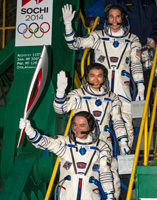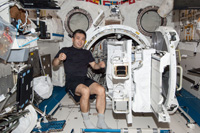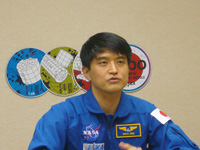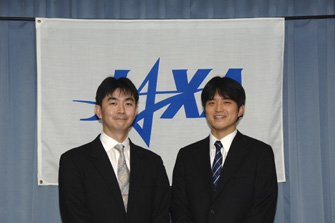There are not many people who receive one phone call that changes their life during their lifetime. I have had three of these in my 37 years on this earth.
The first time was when I was in 4th year at university. I got a call from the HR manager at my old company saying that I had a provisional offer for acceptance as a pilot trainee. The second time was in February, 2009. I received a call from the JAXA astronaut candidate selection test contact person to say that I had an offer for acceptance as an astronaut candidate.
And the third phone call was not so long ago on the morning of the 28th of November in the US. It was from my boss, Flight Crew Operations and Technology Department, to tell me,
‘Your stay as part of the long-duration crew for the Expedition 48/49 mission to the International Space Station (ISS) planned for 2016 has been officially accepted internationally.’
It is four and a half years since I started working at JAXA and I have spent all my time training with the goal of a long-duration mission to the ISS so this phone call can, in a sense, be said to be on the borderline of the same vector of life. This means that, compared to the two previous phone calls that greatly changed the direction of the vector itself, the nature of this call is a little different but, all the same, it is very significant to me in the fact that it gives my future, which was vague up until now, a concrete shape.
Now that I have a specific, fixed goal and that the things I have to do have become clear, my life in the future is probably going to be a lot more simple.
I would like to take this opportunity to thank everyone, both private and public, who has lent their support to my training and lifestyle. My assignment to this mission would not have been possible with my own efforts alone. I would like to say thank you very much to the instructors who taught me during training, the many people who worked hard on international coordination and the people who support JAXA in their everyday lives. I am going to continue to work hard on my training so that I can do even a little good work towards increasing the utilization results of future ISS missions.
Well, there is one more thing I would like to write about this month. This is about a current issue on the ISS. It has been reported in the media so many of you may already know about it.
One of the two external cooling systems on the ISS stopped working on 11th December. It stopped because the temperature of the ammonia in the system was too low.
Before I tell you about this issue, I probably need to explain a little about the importance of cooling systems on the ISS. The ISS is a huge assembly of systems but there are three that are very important. These are the life support system, the electric power system and the cooling system.
The life support system circulates the air, adjusts the temperature, produces oxygen and removes carbon dioxide from the air so that we astronauts can live and work on the ISS. Just as the name suggests, it is a system that is required so that people can stay alive.
And as this equipment, the equipment that is used in experiments and every other single device require electricity, naturally, it is the electric power system that provides this. It is for this reason that the ISS uses huge solar panels. Everyone uses electricity at home so you will easily be able to imagine the importance of the electric power system.
On the ISS, the only other system that cannot be isolated from the electric power system is, in actual fact, the cooling system. This is because mechanisms create and use electricity and therefore also create heat. And if this heat is not adequately removed, devices overheat.
The electric power system and the cooling system are two sides of the same coin and their mutual existence is required if they are to operate normally together. If electrical equipment does not have a cooling device, it will break and if the cooling device doesn’t have electricity, it won’t even work.
It is not surprising that these two core systems that support the ISS have multiple back-up systems. This is why there are two independent external cooling systems on the ISS.
External here refers to the cooling system for the equipment which is installed outside the ISS. Of course, there is also an internal cooling system which cools equipment in the interior of the ISS. The heat that gathers in the internal cooling system is transferred to the external cooling system with a heat exchanger and it is ‘dumped’ into space from a radiator panel that juts out into space.
The external cooling system uses ammonia. Compared with water, etc., this conducts heat more effectively but, on the other hand, it is a substance that is harmful to the human body. The phenomenon that occurred on 11th December when the system itself automatically stopped was due to the temperature of this ammonia being too low. Astronauts are not in danger if the No.1 cooling system stops working but there is a great impact on the ISS systems. For this reason, it can be said to be an extremely routine malfunction dealt with in controller training on the ground and controllers have done a lot of training over the years in dealing with this so this time, the ground control team followed a fixed procedure for the malfunction and the cooling system was soon re-booted.
In actual fact, the re-boot was successful.
However, the temperature of the ammonia was still low. If it stayed this way, it would not be possible to transfer heat between the external and internal cooling systems. This is because water is used instead of ammonia in the internal cooling system in consideration of human safety and there was concern that the cooling water would freeze due to the very low ammonia temperature.
NASA engineers investigated the cause of this and as a result they realized that there was a malfunction in the pump device that circulates the ammonia. To be more specific, one of the valves in this device had stopped doing what it was supposed to do. To give a simple explanation, this valve controls the amount of ammonia that flows into the radiator panel. Through this, the amount of heat radiated is controlled, in other words, the temperature of the ammonia in the system overall is controlled but this valve would only close to a certain point. Due to this, more ammonia than was necessary was flowing into the radiator and there was more heat radiation than was necessary.
After the cause was determined, there was a huge discussion on how to solve the issue. However, unfortunately, there is no way to correct the movement of the valve itself and instead, there was a proposal to control the temperature of the ammonia by adjusting the apertures of other valves. The ground control team tried a number of things by repeated trial and error but, unfortunately, these valves were not originally created for this purpose so it was not possible to make any headway with a solution.
Since the problem occurred, NASA has hypothesized the replacement of the pump device itself through extravehicular activity if it was not possible to restore the system and has made preparations for this in parallel with measures against the malfunction. In addition, simultaneously, in preparation for the worst-case scenario that the other cooling system also stops, this approach has also been discussed a number of times.
Then on Tuesday, 17th December, the ISS programme made the decision to conduct extravehicular activity to replace the pump device. At this stage, it is estimated that two or maybe three extravehicular activities will be required, depending on how the work progresses and the first of these is scheduled to be performed on Saturday 21st.
The extravehicular activity will be performed by 2 American astronauts but Astronaut Wakata will be lending his support from inside the ISS as a robot arm specialist. Furthermore, Astronaut Hoshide is scheduled to participate as a communicator with the ISS in the ground control team and the activities of the two Japanese astronauts are much anticipated in the solution of this situation.
The ISS can be said to be a huge system that is the embodiment of human science and technology but since it was created by humans, it is inevitable that there will be some malfunctions. It is a shame that this malfunction should occur but we should be able to learn a lot from it. I believe that this will be reflected in new system designs in the future and that it will be useful for future space development.
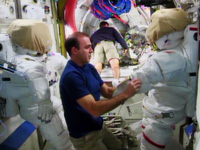
Astronaut Rick Mastracchio conducting an inspection of EVA suits in preparation for extravehicular activity
*Photo: JAXA/NASA

